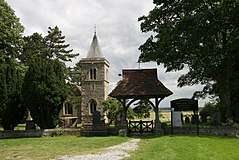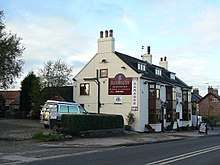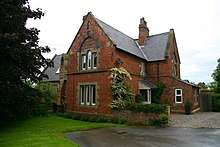Kirby Hill, Harrogate
Kirby Hill, also called Kirby-on-the-Moor, is a village and civil parish about 1 mile (1.6 km) north of the market town of Boroughbridge, in the Harrogate district of North Yorkshire, England.
| Kirby Hill | |
|---|---|
 All Saints' parish church | |
 Kirby Hill Location within North Yorkshire | |
| Population | 391 (2011 Census)[1] |
| OS grid reference | SE389683 |
| Civil parish |
|
| District |
|
| Shire county | |
| Region | |
| Country | England |
| Sovereign state | United Kingdom |
| Post town | York |
| Postcode district | YO51 |
| Dialling code | 01423 |
| Police | North Yorkshire |
| Fire | North Yorkshire |
| Ambulance | Yorkshire |
| UK Parliament | |
| Website | Kirby Hill near Boroughbridge |
Geography
The village is on a section of the Great North Road that is now the B6265. It was part of the A1 until the section of the A1(M) west of the village was built. The village is 85–131 feet (26–40 m) above sea level. The A1(M) motorway passes through the parish just west of the village.
The 2001 Census recorded the population as 355, of whom 294 were more than 16 years old and 168 of these were in employment. There were 155 dwellings of which 105 were detached.[2] The 2011 Census recorded the population as 391.[1]
Manor
The Domesday Book of 1086 records Kirby as Chirchbi in the hundred of Hallikeld. Gospatric, son of Arnketil held the manor of Kirby at the time of the Norman conquest of England. Afterwards the manor was seized by the Crown, but Gospatric remained lord of the manor on behalf of the King.[3]
At some date the manor passed to the Mowbray family, who later sold part of it to Newburgh Priory. After the priory was dissolved in the 16th century the Crown granted the manor to Nevill family of Thornton Bridge. In 1672 the Nevill family sold the manor to Sir Robert Long. In the 19th century the Rawson family of Nidd Hall bought the manor.[4][5]
Church and chapel
Parish church
_-_geograph.org.uk_-_860848.jpg)
The oldest parts of the Church of England parish church of All Saints, Kirby-on-the-Moor are Anglo-Saxon and were built in the 10th-century. In and around the church are 12 stones with Celtic carvings.[6] At the base of the southwest corner of the church is a large granite block with a Roman inscription. It is too weathered to be legible, but it appears to be a dedication to either Antoninus Pius or Caracalla, which would make it second- or early third-century.[7]
The north aisle of the church was added late in the 12th century, with a Norman two-bay arcade inserted into the Saxon north wall of the nave. The chancel is late 12th- or early 13th-century. Later in the 13th century the north chapel was added. It has a squint to the chancel so that a priest celebrating Mass could follow the priest who was doing the same at the high altar. In the 15th century the chancel was enlarged and its present east window with Perpendicular Gothic tracery was inserted.
In 1870 the church was restored under the direction of George Gilbert Scott.[8] The present south porch was built to his Gothic Revival design, incorporating various worked stones ranging from the Saxon era to the 13th century. The church is a Grade I listed building.[9]
The west tower has a ring of six bells. Richard Seliok of Nottingham cast the tenor bell in about 1520. Samuel II Smith of York cast the fourth bell in 1713 and the fifth bell in 1718. John Warner & Sons of Cripplegate, London cast the treble, second and third bells in 1869.[10]
Economic and social history
In a rebellion of barons against Edward II in 1322, Sir Andreas de Harcla mustered his army near Kirby Hill before the Battle of Boroughbridge.[11]

The Pilmoor, Boroughbridge and Knaresborough Railway ran through the parish. It was opened from Pilmoor Junction on the East Coast Main Line to Boroughbridge in 1847[4][5] and operated by the North Eastern Railway. In 1875 it was extended from Boroughbridge to Knaresborough. In 1964 British Railways closed the line.[12]
From 1996 to 2019 residents of Kirby Hill campaigned to stop a developer, Heather Ive Associates, from gaining planning permission for a motorway service area on the A1(M) about 500 yards (460 m) north-west of the village.[13] A campaign group, Kirby Hill RAMS (Residents Against Motorway Services) opposed the development. Led by its Chairman, Gareth Owens, RAMS succeeded in opposing the plans at when they came before Harrogate Borough Council's Planning Committee and at three major public inquiries when the developer appealed. On 16 October 2012 the then Secretary of State for Communities and Local Government, Eric Pickles, formally rejected the plan after the third public inquiry.[14] On 19 November 2019, Harrogate Borough Council's Planning Committee rejected a new MSA scheme at the same site proposed by Applegreen.
Kirby Hill has a pub, the Blue Bell Inn.[15] It is on Leeming Lane, the main road through the village.
Schools

Kirby Hill Church of England Primary School has a modern school building, opened in June 2002. The old school near the Vicarage was built in 1867.[4][16]
For secondary education the parish is in the catchment area of Boroughbridge High School[17] and Ripon Grammar School.
Governance
Kirby Hill and District Parish Council has eight members.[18] The parish is in the Bishop Monkton & Newby ward of the Borough of Harrogate (district council); the Boroughbridge electoral division of North Yorkshire County Council and the Skipton and Ripon constituency of the UK Parliament.[19]
References
- UK Census (2011). "Local Area Report – Kirby Hill Parish (1170217031)". Nomis. Office for National Statistics. Retrieved 24 March 2018.
- "Kirby Hill (CP)". Neighbourhood Statistics. Office for National Statistics. Retrieved 27 December 2012.
- Kirby Hill in the Domesday Book. Retrieved 1 January 2013.
- Bulmer 1890, p. 733.
- Page 1914, pp. 367–371.
- Lang 2002, p. 129.
- "No title". Archaeology Data Service.
- Pevsner 1966, p. 210.
- Historic England. "Church of All Saints (Grade I) (1190293)". National Heritage List for England. Retrieved 6 December 2017.
- Aspland, Andrew (4 June 2015). "Kirby Hill All Saints or Kirby on the Moor". Dove's Guide for Church Bell Ringers. Central Council of Church Bell Ringers. Retrieved 6 December 2017.
- "History". Retrieved 10 January 2018.
- "Local History" (PDF). Archived from the original (PDF) on 1 August 2014. Retrieved 1 January 2013.
- "Anger at late changes to A1 services plan". The North Yorkshire News. Johnston Press. 6 January 2011.
- "Motorway Service Areas (MSA) on the A1(M) at Kirby Hill" (PDF). 16 October 2012. Archived from the original (PDF) on 19 September 2012. Retrieved 6 May 2017.
- Blue Bell at Kirby Hill
- "School History". Archived from the original on 15 April 2013. Retrieved 1 January 2013.
- "Education". North Yorkshire County Council. Archived from the original on 1 November 2012. Retrieved 1 January 2013.
- "Members For: Kirby Hill and District Parish Council". Harrogate Borough Council. Retrieved 6 December 2017.
- "Polling district and wards | Harrogate Borough Council" (PDF). www.harrogate.gov.uk. February 2018. p. 3. Retrieved 7 April 2020.
Bibliography
- Bulmer (1890). Bulmer's Topography, History and Directory (Private and Commercial) of North Yorkshire. S&N Publishing. p. 733. ISBN 1-86150-299-0.CS1 maint: ref=harv (link)
- Lang, James (2002). Corpus of Anglo-Saxon Stone Sculpture. London: Oxford University Press for the British Academy. ISBN 978-0197262566.CS1 maint: ref=harv (link)
- Page, William, ed. (1914). "Kirkby Hill or Kirkby on the Moor". A History of the County of York North Riding. Victoria County History. I. London: Constable & Co. pp. 367–371.CS1 maint: ref=harv (link)
- Pevsner, Nikolaus (1966). Yorkshire: the North Riding. The Buildings of England. Harmondsworth: Penguin Books. p. 210. ISBN 0-14-071029-9.CS1 maint: ref=harv (link)
External links
| Wikimedia Commons has media related to Kirby Hill, Harrogate. |